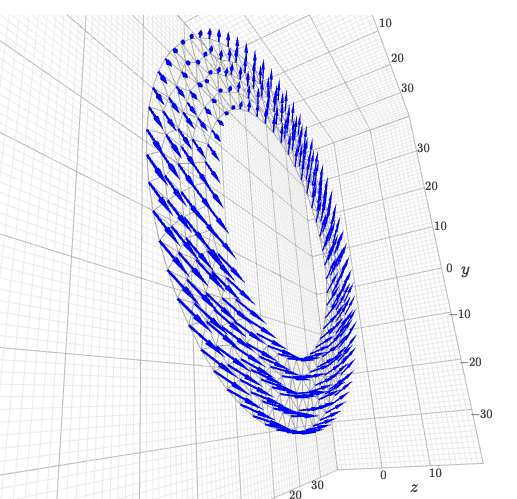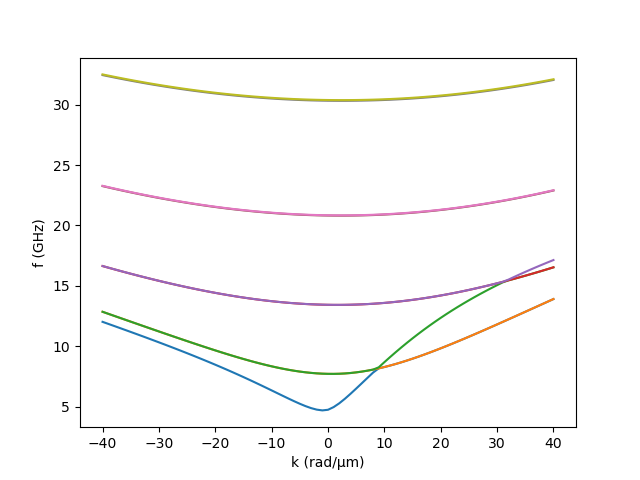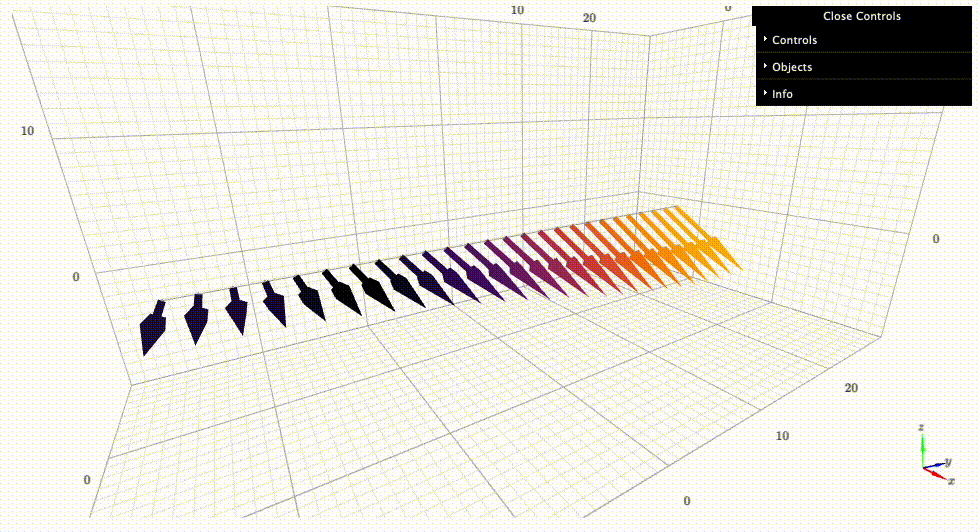TetraX
TetraX is a package for finite-element-method (FEM) micromagnetic modeling with the aim of providing user-friendly and versatile micromagnetic workflows. Among other features, it allows to efficiently calculate spin-wave spectra in different magnetic systems of general geometries.
Description

TetraX is a package for finite-element-method (FEM) micromagnetic modeling with the aim to provide user friendly and versatile micromagnetic workflows. Apart from energy minimizers and an LLG solver, it aims to provide implementations of several FEM dynamic-matrix approaches to numerically calculate the normal modes and associated frequencies for magnetic specimen of different geometries such as confined samples, infinitely long waveguides, or infinitely extended multilayers. Apart from ferromagnets, the package also supports antiferromagnets as an experimental feature.
| Magnetic equilibria | Spin-wave dispersions | Mode profiles |
|---|---|---|
 |  |  |
and more.
Getting start
For a quick introduction, how to start your own FEM micromagnetic simulations, visit our Getting started page and take a look at the provided Examples.
Do you need help?
If you need help and cannot find it in the documentation, or just want to discuss with other users, head over to discussions.tetrax.software where you will find the official TetraX discourse forum.
Cite us
If you use TetraX for your research, please cite
- L. Körber, G. Quasebarth, A. Hempel, F. Zahn, A. Otto, E. Westphal, R. Hertel and A. Kákay (2022). "TetraX: Finite-Element Micromagnetic-Modeling Package", Rodare. DOI: 10.14278/rodare.1418
- L. Körber, G. Quasebarth, A. Otto and A. Kákay, "Finite-element dynamic-matrix approach for spin-wave dispersions in magnonic waveguides with arbitrary cross section", AIP Advances 11, 095006 (2021)
- L. Körber, A. Hempel, A. Otto, R. A. Gallardo, Y. Henry, J. Lindner and A. Kákay, "Finite-element dynamic-matrix approach for propagating spin waves: Extension to mono- and multi-layers of arbitrary spacing and thickness", AIP Advances 12, 115206 (2022)
@misc{TetraX,
author = {Körber, Lukas and
Quasebarth, Gwendolyn and
Hempel, Alexander and
Zahn, Friedrich and
Otto, Andreas and
Westphal, Elmar and
Hertel, Riccardo and
Kakay, Attila},
title = {{TetraX: Finite-Element Micromagnetic-Modeling
Package}},
month = jan,
year = 2022,
doi = {10.14278/rodare.1418},
url = {https://doi.org/10.14278/rodare.1418}
}
@article{korberFiniteelementDynamicmatrixApproach2021a,
title = {Finite-element dynamic-matrix approach for spin-wave dispersions
in magnonic waveguides with arbitrary cross section},
volume = {11},
doi = {10.1063/5.0054169},
language = {en},
journal = {AIP Advances},
author = {Körber, L and Quasebarth, G and Otto, A and Kákay, A},
year = {2021},
pages = {095006},
}
@article{korberFiniteelementDynamicmatrixApproach2022,
title = {Finite-element dynamic-matrix approach for propagating spin waves: Extension to mono- and multi-layers of arbitrary spacing and thickness},
volume = {12},
doi = {10.1063/5.0107457},
language = {en},
journal = {AIP Advances},
author = {Körber, L and Hempel, A and Otto, A and Gallardo, R A and Henry, Y and Lindner, J and Kákay, A},
year = {2022},
pages = {115206},
}
The numerical experiments implemented in TetraX are often based on seminal papers. In order to give credit to these works, when conducting a numerical experiment, TetraX saves references important for this experiment to a bibtex file called "references.bib", found in the sample directory. In this file, each entry contains a comment field describing how the reference was important for the computation. When publishing results calculated with TetraX in your research, please also give credit to the works which are important for the numerical experiments you conducted.
Publications using our Software
- F. Brevis et al., "Curvature-induced parity loss and hybridization of magnons: Exploring the connection of flat and tubular magnetic shells" (arXiv:
https://doi.org/10.48550/arXiv.2408.04416) - L. Körber, "Spin waves in curved magnetic shells", PhD Thesis, TU Dresden (2023)
- C. Riedel, "Local Control and Manipulation of Propagating Spin Waves Studied by Time-Resolved Kerr Microscopy", PhD Thesis, TU Müchchen (2023)
- C. Riedel et al., "Hybridization-Induced Spin-Wave Transmission Stop Band within a 1D Diffraction Grating", Advanced Physics Research 2, 2200104 (2023) ( https://doi.org/10.1002/apxr.202200104)
- V. Iurchuk et al., "Tailoring crosstalk between localized 1D spin-wave nanochannels using focused ion beams", Scientific Reports 13, 764 (2023) (https://doi.org/10.1038/s41598-022-27249-w)
- T. Hache et al., "Control of Four-Magnon Scattering by Pure Spin Current in a Magnonic Waveguide", Physical Review Applied 20, 014062 (2023) (http://dx.doi.org/10.1103/PhysRevApplied.20.014062)
- L. Körber et al., "Curvilinear spin-wave dynamics beyond the thin-shell approximation: Magnetic nanotubes as a case study", Physical Review B 106, 014405 (2022) (https://doi.org/10.1103/PhysRevB.106.014405)
- L. Körber et al., "Symmetry and curvature effects on spin waves in vortex-state hexagonal nanotubes", Physical Review B 104, 184429 (2021) (https://doi.org/10.1103/PhysRevB.104.184429)
- L. Körber and A. Kákay, "Numerical reverse engineering of general spin-wave dispersions: Bridge between numerics and analytics using a dynamic-matrix approach", Physical Review B 104, 174414 (2021) (https://doi.org/10.1103/PhysRevB.104.174414)
- L. Körber et al., "Mode splitting of spin waves in magnetic nanotubes with discrete symmetries", Physical Review B 105, 184435 (2022) (https://doi.org/10.1103/PhysRevB.105.184435)
Publications citing our Software and Method
- F. Brevis et al., "Curvature-induced parity loss and hybridization of magnons: Exploring the connection of flat and tubular magnetic shells" (arXiv:
https://doi.org/10.48550/arXiv.2408.04416) - O. Volkov et al., "Three-dimensional magnetic nanotextures with high-order vorticity in soft magnetic wireframes" Nature Communications 15 (2024) 2193 (https://doi.org/10.1038/s41467-024-46403-8)
- D.E. Gonzales-Chaves et al., "Solutions to the Landau–Lifshitz–Gilbert equation in the frequency space: Discretization schemes for the dynamic-matrix approach", JMMM 603 (2024) 172179 (https://doi.org/10.1016/j.jmmm.2024.172179)
- Kraft et al., "Parallel-in-time integration of the Landau–Lifshitz–Gilbert equation with the parallel full approximation scheme in space and time", JMMM 597, 171998 (2024) (https://doi.org/10.1016/j.jmmm.2024.171998)
- L. Körber, "Spin waves in curved magnetic shells", PhD Thesis, TU Dresden (2023)
- C. Riedel, "Local Control and Manipulation of Propagating Spin Waves Studied by Time-Resolved Kerr Microscopy", PhD Thesis, TU Müchchen (2023)
- A.V. Chumak et al., "Advances in magnetics roadmap on spin-wave computing", IEEE Transactions on Magnetics 58, 0800172 (2022) (https://doi.org/10.1109/TMAG.2022.3149664)
- C. Riedel et al., "Hybridization-Induced Spin-Wave Transmission Stop Band within a 1D Diffraction Grating", Advanced Physics Research 2, 2200104 (2023) ( https://doi.org/10.1002/apxr.202200104)
- R.A. Gallardo et al., "High spin-wave asymmetry and emergence of radial standing modes in thick ferromagnetic nanotubes", Physical Review B 105, 104435 (2022) (https://doi.org/10.1103/PhysRevB.105.104435)
- O. Gladii et al., "Spin-wave nonreciprocity at the spin-flop transition region in synthetic antiferromagnets", Physical Review B 107, 104419 (2023) (https://doi.org/10.1103/PhysRevB.107.104419)
- R.A. Gallardo et al., "Unidirectional Chiral Magnonics in Cylindrical Synthetic Antiferromagnets", Physical Review Applied 18, 054044 (2022) (http://dx.doi.org/10.1103/PhysRevApplied.18.054044)
- V. Iurchuk et al., "Tailoring crosstalk between localized 1D spin-wave nanochannels using focused ion beams", Scientific Reports 13, 764 (2023) (https://doi.org/10.1038/s41598-022-27249-w)
- T. Hache et al., "Control of Four-Magnon Scattering by Pure Spin Current in a Magnonic Waveguide", Physical Review Applied 20, 014062 (2023) (http://dx.doi.org/10.1103/PhysRevApplied.20.014062)
- L. Körber et al., "Curvilinear spin-wave dynamics beyond the thin-shell approximation: Magnetic nanotubes as a case study", Physical Review B 106, 014405 (2022) (https://doi.org/10.1103/PhysRevB.106.014405)
- L. Körber et al., "Symmetry and curvature effects on spin waves in vortex-state hexagonal nanotubes", Physical Review B 104, 184429 (2021) (https://doi.org/10.1103/PhysRevB.104.184429)
- L. Körber and A. Kákay, "Numerical reverse engineering of general spin-wave dispersions: Bridge between numerics and analytics using a dynamic-matrix approach", Physical Review B 104, 174414 (2021) (https://doi.org/10.1103/PhysRevB.104.174414)
- L. Körber et al., "Mode splitting of spin waves in magnetic nanotubes with discrete symmetries", Physical Review B 105, 184435 (2022) (https://doi.org/10.1103/PhysRevB.105.184435)
Source & license
The source code of TetraX is licensed under the GNU GPL v3.0 Open-Source license.

- GPL-3.0
- Open Access
Participating organisations
Mentions
- 1.Author(s): D.E. Gonzalez-Chavez, G.P. Zamudio, R.L. SommerPublished in Journal of Magnetism and Magnetic Materials by Elsevier BV in 2024, page: 17217910.1016/j.jmmm.2024.172179
- 2.Author(s): Robert Kraft, Sabri Koraltan, Markus Gattringer, Florian Bruckner, Dieter Suess, Claas AbertPublished in Journal of Magnetism and Magnetic Materials by Elsevier BV in 2024, page: 17199810.1016/j.jmmm.2024.171998
- 3.Author(s): Vadym Iurchuk, Javier Pablo-Navarro, Tobias Hula, Ryszard Narkowicz, Gregor Hlawacek, Lukas Körber, Attila Kákay, Helmut Schultheiss, Jürgen Fassbender, Kilian Lenz, Jürgen LindnerPublished in Scientific Reports by Springer Science and Business Media LLC in 202310.1038/s41598-022-27249-w
- 4.Author(s): T. Hache, L. Körber, T. Hula, K. Lenz, A. Kákay, O. Hellwig, J. Lindner, J. Fassbender, H. SchultheissPublished in Physical Review Applied by American Physical Society (APS) in 202310.1103/physrevapplied.20.014062
- 5.Author(s): C. Riedel, T. Taniguchi, L. Körber, A. Kákay, C. H. BackPublished in Advanced Physics Research by Wiley in 202310.1002/apxr.202200104
- 6.Author(s): O. Gladii, R. Salikhov, O. Hellwig, H. Schultheiss, J. Lindner, R. A. GallardoPublished in Physical Review B by American Physical Society (APS) in 202310.1103/physrevb.107.104419
- 7.Author(s): R.A. Gallardo, P. Alvarado-Seguel, P. LanderosPublished in Physical Review Applied by American Physical Society (APS) in 202210.1103/physrevapplied.18.054044
- 8.Author(s): Lukas Körber, István Kézsmárki, Attila KákayPublished in Physical Review B by American Physical Society (APS) in 202210.1103/physrevb.105.184435
- 9.Author(s): R. A. Gallardo, P. Alvarado-Seguel, P. LanderosPublished in Physical Review B by American Physical Society (APS) in 202210.1103/physrevb.105.104435
- 10.Author(s): L. Körber, R. Verba, Jorge A. Otálora, V. Kravchuk, J. Lindner, J. Fassbender, A. KákayPublished in Physical Review B by American Physical Society (APS) in 202210.1103/physrevb.106.014405
- 11.Author(s): A. V. Chumak, P. Kabos, M. Wu, C. Abert, C. Adelmann, A. O. Adeyeye, J. Akerman, F. G. Aliev, A. Anane, A. Awad, C. H. Back, A. Barman, G. E. W. Bauer, M. Becherer, E. N. Beginin, V. A. S. V. Bittencourt, Y. M. Blanter, P. Bortolotti, I. Boventer, D. A. Bozhko, S. A. Bunyaev, J. J. Carmiggelt, R. R. Cheenikundil, F. Ciubotaru, S. Cotofana, G. Csaba, O. V. Dobrovolskiy, C. Dubs, M. Elyasi, K. G. Fripp, H. Fulara, I. A. Golovchanskiy, C. Gonzalez-Ballestero, P. Graczyk, D. Grundler, P. Gruszecki, G. Gubbiotti, K. Guslienko, A. Haldar, S. Hamdioui, R. Hertel, B. Hillebrands, T. Hioki, A. Houshang, C.-M. Hu, H. Huebl, M. Huth, E. Iacocca, M. B. Jungfleisch, G. N. Kakazei, A. Khitun, R. Khymyn, T. Kikkawa, M. Klaui, O. Klein, J. W. Klos, S. Knauer, S. Koraltan, M. Kostylev, M. Krawczyk, I. N. Krivorotov, V. V. Kruglyak, D. Lachance-Quirion, S. Ladak, R. Lebrun, Y. Li, M. Lindner, R. Macedo, S. Mayr, G. A. Melkov, S. Mieszczak, Y. Nakamura, H. T. Nembach, A. A. Nikitin, S. A. Nikitov, V. Novosad, J. A. Otalora, Y. Otani, A. Papp, B. Pigeau, P. Pirro, W. Porod, F. Porrati, H. Qin, B. Rana, T. Reimann, F. Riente, O. Romero-Isart, A. Ross, A. V. Sadovnikov, A. R. Safin, E. Saitoh, G. Schmidt, H. Schultheiss, K. Schultheiss, A. A. Serga, S. Sharma, J. M. Shaw, D. Suess, O. Surzhenko, K. Szulc, T. Taniguchi, M. Urbanek, K. Usami, A. B. Ustinov, T. van der Sar, S. van Dijken, V. I. Vasyuchka, R. Verba, S. Viola Kusminskiy, Q. Wang, M. Weides, M. Weiler, S. Wintz, S. P. Wolski, X. ZhangPublished in IEEE Transactions on Magnetics by Institute of Electrical and Electronics Engineers (IEEE) in 2022, page: 1-7210.1109/tmag.2022.3149664
- 12.Author(s): L. Körber, A. KákayPublished in Physical Review B by American Physical Society (APS) in 202110.1103/physrevb.104.174414
- 13.Author(s): Lukas Körber, Michael Zimmermann, Sebastian Wintz, Simone Finizio, Matthias Kronseder, Dominique Bougeard, Florian Dirnberger, Markus Weigand, Jörg Raabe, Jorge A. Otálora, Helmut Schultheiss, Elisabeth Josten, Jürgen Lindner, István Kézsmárki, Christian H. Back, Attila KákayPublished in Physical Review B by American Physical Society (APS) in 202110.1103/physrevb.104.184429
- 1.Author(s): Lukas KörberPublished in 2024
- 2.Author(s): Lukas KörberPublished in 2024
- 3.Author(s): Lukas Körber, Gwendolyn Quasebarth, Alexander Hempel, Andreas Otto, Jürgen Fassbender, Attila KákayPublished in 2023
- 4.Author(s): Lukas KörberPublished in 2023
- 5.Author(s): Lukas Körber, Gwendolyn Quasebarth, Alexander Hempel, Andreas Otto, Jürgen Fassbender, Attila KákayPublished in 2023
- 6.Author(s): Lukas Körber, Gwendolyn Quasebarth, Alexander Hempel, Andreas Otto, Jürgen Fassbender and Attila KákayPublished in 2023
- 7.Author(s): Lukas Körber, Gwendolyn Quasebarth, Alexander Hempel, Andreas Otto, Jürgen Fassbender, and Attila KákayPublished in 2022
Testimonials
The TetraX made possible quick interpretation of experimental results in complex geometries. The effectiveness and speed of calculations ensure that the feedback is provided almost immediately, in contrast to the “heavy and slow” finite difference micromagnetic solvers and subsequent Fourier analysis.